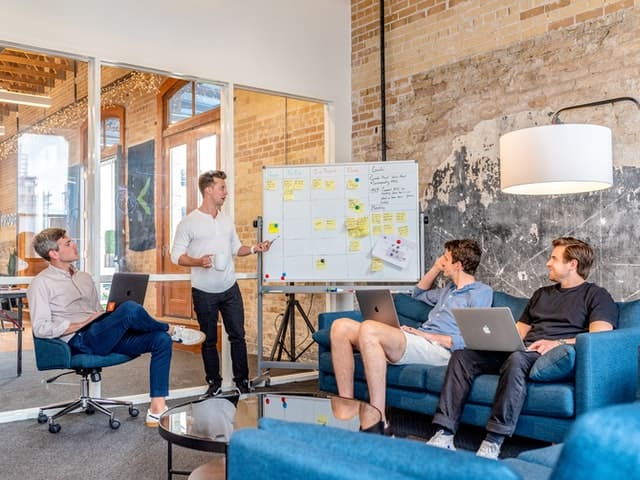How can I make my business more sustainable – is that what you’re wondering? That’s a great question to ask! Making your company more environmentally-friendly is good for business, improves brand reputation, and brings teams closer together as they work toward a greater good.
Many professionals are looking for ways the businesses they own or work for can become more sustainable or more eco-friendly.
In this piece, you will find 4 effective ways to answer the question “how can I make my organization or business more sustainable?”
In contrast, you will find nothing on greenwashing, i.e., how to create the perception you’re doing more than you’re actually doing.
Instead, you will learn 3 effective ways to make your business more sustainable. Plus an introduction to sustainability basics.
These sustainability actions we’re about to discuss stand upon the idea – “stolen” from Eric Holthaus’ book The Future Earth (2020) – that there are only 2 types of people.
Those who acknowledge we’re on the brink of crossing important planetary tipping points. And those who don’t.
1 – Where To Start? A Quick “Business Sustainability” Introduction

Let’s make a quick overview of the basic sustainability actions a business trying to be green more eco-friendly should set in motion.
Odds are you might have heard or thought about some of them already.
Making your organization go paperless and making sure it uses digital tools in an eco-friendly way might be something your company has already implemented or thought about?
Likewise, switching to electric mobility and to electric cars when this need shows up can be important too. And indeed many businesses have started walking this path as the demand for electric vehicles has been on the rise.
Moreover, some innovative and trendy businesses have also started bringing green walls inside their offices and benefiting from their ability to regulate the temperature and purify the air.
Implementing recycling programs is an interesting idea too, together with changing the light bulbs in your office to LEDs or reducing the AC’s temperature.
Using cut-out switches to cut out standby power usage or having power supplied by renewable energy providers are also initiatives worth exploring and implementing.
And they’ll most likely have a positive impact not only on the environment but also on the company’s wallet.
You can find some of these issues explored more in-depth in our article: 20 Simple Steps To Make Your Business More Sustainable and Eco-Friendly.
These are important steps in making your organization more sustainable and eco-friendly. And implementing some of them will still be relatively time-consuming and challenging. But mind that they’re “just” the basics.
Remember earlier when I spoke of greenwashing?
Well, creating huge marketing campaigns around these “basics” – or even writing dedicated website pages – are often seen as greenwashing. Precisely because some of these initiatives are just the starting point.
From a consumer perspective – who expects a lot from businesses regarding helping to build a better society – they’re not a good to have but a must have.
Maybe some 10 years ago or earlier they meant something big that consumers would be proud of.
But right now, at the stage we’re at, consumers already expect these sustainability actions to be in motion and businesses to have a more meaningful impact.
Here’s where companies can start becoming a little extraordinary: by creating a sustainability strategy and measuring it.
It might seem like a big deal – but it is not.
Some people have approached me saying they wanted to start develop real-impact sustainability initiatives and asking for advice on where they should start with or what resources they should first read.
Coming right next, on step 2 of “how to make your organization more sustainable”, I’ll share with you how you can do this inside your organization.
Stick with me.
2 – Creating a Sustainability Strategy: the Main Answer to “How to Make My Organization More Sustainable?”

Within a couple of groups from the regenerative movement there’s this motto: “if it’s not fun, it’s not sustainable”.
While this is partially right, the other part requires a substantial amount of work because often the most meaningful changes organizations need to make have to do with their core activities.
But it’s not that hard, so don’t give just yet. In fact, step one is quite easy: understanding where your organization stands.
And this has way more to do with business strategy than with sustainability – though they should walk hand in hand as we’ll see ahead.
This means reflecting and considering hypothetical risks – like the ones the World Economic Forum has just released – an industry might face on a global and regional level. As well as the particular changes a business might be forced to make in response.
But also trying to predict opportunities within the industry and potentialize your organization’s strengths while working on improving its weaknesses.
And during this reasoning, remember to think about how sustainability relates or can relate to the long-term success and strategy of your organization.
That’s step 2. Write it down. Co-create a document with others who might see what you’re not considering or have a different perspective.
Then, assessing your organization’s impacts comes next.
However, there are many impacts, right? Don’t worry, you don’t have to tackle them all at once – that’s the good part!
What’s usually done – which also happens when businesses want to apply to be certified as sustainable by some renowned brands such as B Corp or GRI – is to assess the main impacts related to your business using a materiality assessment.
For instance, if your company grows and harvests olives and almonds, your agriculture practices have an impact. At the same time, drought or other extreme weather events – that are becoming increasingly frequent – might be a risk for your crop yields. This is an important short/medium-term impact/risk this organization needs to work on.
The machines they use for harvesting run on fossil fuels and have an impact too.
But perhaps it is not as urgent to address as the one above. Or the impacts of a water supply that’s being contaminated by synthetic fertilizers or pesticides and whose use will no longer be viable in 2 years.
At the same time, organizations also need to address the worries of their main stakeholders. Because what’s not a great deal for your organization might be important to a party whose support you need.
Let’s think of solar panel sellers. They also have their impacts, right?
Imagine that suddenly the media starts focusing a lot on the impacts of discarding lithium batteries and how there’s no scalable solution at this point to the pollution they create.
This will be an impact/risk the company selling solar panels will need to consider despite their business being on the selling end.
Because they don’t want people not to buy solar panels because discarding them isn’t eco-friendly, they should address this issue.
That’s how you prioritize which impacts to address first: mixing your main impacts and risks with those of your most important stakeholders.
Once you found your impacts and selected the main ones to be tackled, you’ll need to measure them so you know what you’re dealing with and how to bet on other alternatives.
Only then should you look for different options – you can see what others in your industry are already doing, collect feedback from your staff, hire a specialized consultant to help you out…
Remember you’ll need to measure and monitor the alternative method, model, activity, product, part, or other, to make sure you’re truly making a difference and making your business more sustainable.
This will also provide you with data to share on your sustainability and CSR report.
You can find more information on this in our piece: Should SMBs Have A CSR Or Sustainability Strategy? How Can They Create It?
Many companies have done these sustainability strategy exercises and working on real, meaningful changes – with carbon offsetting being among the latest trends.
But there’s another trend your business could also benefit from.
3 – Sustainable Organizations Educate Employees and Create a Sustainability Culture

This is all about empowering a company’s employees with knowledge on sustainability, environmental protection, and social issues.
So that the organizational culture can become one where sustainability is truly lived and not just spoken of.
Our brains are wired to anticipate the future for survival purposes – particularly when we’re under stress.
If we think about it, being in the present moment and calmly considering how we’re feeling and what’s surrounding us at a given moment without worrying about what might happen next even has a name: mindfulness.
Businesses would benefit from adopting mindfulness practices too. But that’s not the point here.
The point is that it’s easier for our brains to eat a tasty beef every day than to imagine how some faraway land might get totally depleted and waste its water reservoirs to raise cattle.
Hence why sustainable behaviors are often hard to implement. Yet so important.
So organizing training sessions where the staff can learn about some eco-friendly behaviors to adopt both at home and at home is a good idea.
Plus, these moments can also be useful to collect feedback from them on impacts they might have noticed. And to let them know the company’s sustainability strategy that’s being, or will be, set into motion.
This will not only help create a culture where sustainability is truly lived.
The staff will probably be proud to work for an organization that’s actively trying to be friendlier to the environment.
4 – A Sustainable Business Actively Contributes to the Systemic Changes That Need to Take Place

That’s right.
Contributing to systemic changes that need to take place.
That should be part of your business too. But don’t take my word for it, take IPCC’s – the UN’s body known as the Intergovernmental Panel on Climate Change.
They say we need to upscale and accelerate the implementation of far-reaching, multilevel and cross-sectoral climate mitigation and addressing barriers. Such systemic change would need to be linked to complementary adaptation actions, including transformational adaptation.
If we honestly think about it, many of today’s problems are what Elkington – known as the grandfather of sustainability – calls wicked problems.
These are global, complex, and interconnected problems.
And there’s no simple solution to a complex problem. Particularly when we’re humble enough to accept climate change isn’t the problem – it’s a symptom of the problem.
It’s more about how we see ourselves and our place in the grand order of things. And doing business keeping in mind there’s no good business in a collapsing society and a planet where the biosphere isn’t able to regulate itself and secure the balance that allows us humans, and our businesses, to thrive.
Ultimately, sustainable business is about making some hard choices. And sometimes, it may mean to completely reimagine the way we’ve been doing business since the Industrial Revolution.
Having the circular economy and the way Nature works more on the agenda, for instance.
From adapting the office and improving it. To redesigning the core business and changing some major activities. Plus setting a culture of sustainability into motion so that sustainability grows organically.
But, again, successful companies are the ones thinking some 20 or 30 years ahead.
Nearly 2 decades ago, developing, implementing, and getting the funds to start manufacture electric cars was more complicated than keeping on producing thermal cars.
Just like testing new cereal-based drinks, such as oat-“milk” which is among the most eco-friendly ones, as milk-alternatives was harder than repeating the modus operandi of milk production.
And few people had Steve Job’s eagerness to shape the telecom/ entertainment industry back when the first iPhone was released.
It may be more complicated and require more time, more meetings, more learning, or spending more trouble.
But not walking this innovation and sustainability path, and not changing a business to be prepared for the foreseeable future, may mean short-term success but staying obsolete in the next decade.
Moreover, when we look at how Nature works – an innovation process known as biomimicry – we see there’s no such thing as a healthy species in a decaying ecosystem.
So saving some time to actively help shape your industry and work together on how systemic change can take place is fundamental too for long term success.
The best way to work with other businesses is to talk regularly with them.
There are plenty of groups, societies, organizations, and events dedicated to the networking of sustainable business leaders. Find them out, make contacts, organize meetings, connect with the public sector and start shaping what’s to come.
Ideally, finding alternative and sustainable business models is a way to go. Like Patagonia did by creating clothes repairing centers.
IKEA is reselling used furniture too and plant-based protein meatballs. Fairphone leads in eco-designed mobile phones.
Sustainable businesses have understood that people and the planet have to come first.
So they’re making money from what they don’t do: less pollution, producing less waste, and sending it upstream to be reused, or reducing and offsetting greenhouse gas emissions.
Yes, more money, time, and energy will likely be spent for businesses to become more environmentally and people-friendly. But if the sustainability transition is done right, it will be worth it in the medium-term.
Worth for businesses. Worth for the planet. And worth for everyone.
[Photos by Erin Doering, Ergita Sela, Austin Distel and Mat Reding on Unsplash]

